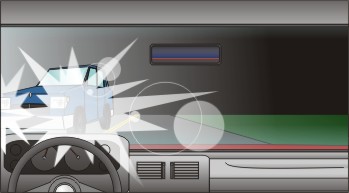
We drive in environmental conditions each time we make a trip. Understanding better how to handle changing conditions will make the trip more enjoyable and safer. Dealing with too much light, such as the sun in your eyes, may be handled by wearing good sunglasses or properly using the sun visor. Remember always have the lower edge of the sun visor pushed toward the windshield.
Night driving brings on adjustments that you must deal with successfully. Aside from reducing detail, darkness conceals hazards: pedestrians, bicycles, stalled cars, curves and other objects or conditions. You must make a decision on the basis of a sketchy and incomplete picture. It is more difficult to judge the speed and position of other vehicles. You must depend largely on your headlights, which will show only a relatively short and narrow path ahead. It does not bend around corners. Usually, adequate highway lighting is limited. Glare from roadside lighting and the headlights of on-coming vehicles may impair your visibility. Keep your panel lights dim for better vision, but always have enough panel light to read your speedometer and other gauges. Reduce speed so that you can stop within the visible distance. Increase seeing distance by keeping the headlights clean and properly aimed and the windshield clean.
There are other visibility conditions we must consider to drive safe, such as fog, haze, smoke and mist that can affect our visibility greatly. Remember, Florida law requires that we turn on our low beam headlights and use our windshield wipers under such conditions. Never drive with only parking lights on. Be alert for slow moving and or stopped traffic. Check your rearview mirrors frequently for vehicles that are approaching quickly from the rear. Be especially careful for patches of fog in valleys and low-lying areas. If possible, drive slowly but keep moving. But if conditions are too bad, pull over as far to the right, off the main travel portion of the roadway as possible and stop. Leave your parking lights on and activate your hazard lights.

Driving in the rain is a hazard that we must consider. During rainy conditions when the roads are wet, we must realize our stopping distance is increased. When braking, friction between your tires and the surface of the roadway affect your stopping distance. Wet roads have less friction and increase the distance it takes you to stop. Driving through water may cause hydroplaning. The purpose of the tread on a tire is to prevent hydroplaning from happening; that is why the law requires tire treads to meet certain standards. As little as 1/16 of an inch of water can cause hydroplaning.
Hydroplaning occurs when your tires ride on a thin layer of water and do not touch the road. When the car is riding on a film of water there is no friction between your tires and the road. Hydroplaning also affects our ability to steer and brake.
Do not drive through large bodies of standing water as it can affect brake performance, the vehicle's electrical system, and cause engine failure which could result in costly repairs. If the standing water is concentrated on one portion of the road and only one side of the vehicle goes through the water the vehicle will tend to pull in that direction. The force of the pull is dependent on the depth of the water and the speed of the vehicle.
Simply put, remember, as you approach the standing water, a good habit to get into may be lifting your foot off the gas pedal and to check your rearview mirror for vehicles that may be following you too closely.
Remember:
- Slow down before hitting the water.
- Turn wipers on before hitting the water.
- Tap brakes as you exit.
- Use caution in checking outside mirrors. Rain can distort or obliterate images.
- Do not drive through standing water if you do not know how deep it is.
Wind can also become a problem, especially when driving large vehicles, such as a truck or a motor home. Be alert for cross gusts when leaving overpasses, large buildings or other large areas where the wind is being blocked from striking your vehicle.
An ongoing problem with wind gusts is when you are being passed by large vehicles such as tractor trailers or buses traveling in the same direction. As you are traveling wind gusts from these vehicles can make your car more difficult to control. As these vehicles start to pass you, grip your steering wheel firmly. You may also want to reduce your speed a little.
Environmental Causes
Florida Traffic Crash Facts – 2004
Lighting Conditions at the Time of Crash
| Lighting Conditions | All Crashes | Fatal Crashes | Injury Crashes | Property Damage |
|---|---|---|---|---|
| Daylight | 161,487 | 1,290 | 97,669 | 62,528 |
| Dusk | 7,010 | 75 | 3,949 | 2,986 |
| Dawn | 3,344 | 60 | 1,897 | 1,387 |
| Darkness | 76,636 | 1,498 | 37,867 | 37,271 |
| Unknown | 4,425 | 13 | 1,006 | 3,406 |
| Total | 252,902 | 2,936 | 142,388 | 107,578 |
Road Surface Conditions at the Time of Crash3
| Surface Conditions | All Crashes | Fatal Crashes | Injury Crashes | Property Damage |
|---|---|---|---|---|
| Dry | 215,862 | 2,618 | 121,684 | 91,560 |
| Wet | 32,087 | 298 | 18,641 | 13,148 |
| Slippery | 1,383 | 5 | 885 | 493 |
| Icy | 67 | 2 | 32 | 33 |
| Other | 3,503 | 13 | 1,146 | 2,344 |
| Total | 252,902 | 2,936 | 142,388 | 107,578 |
No comments:
Post a Comment